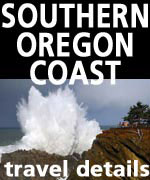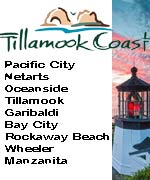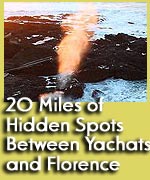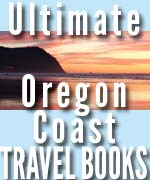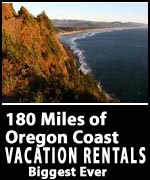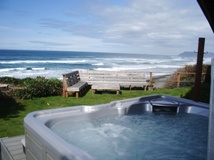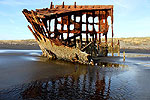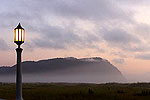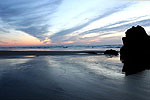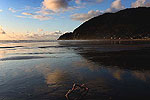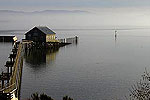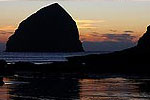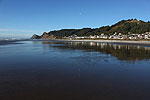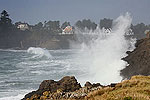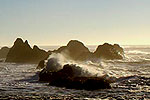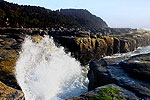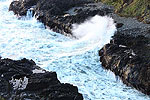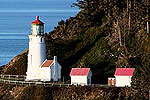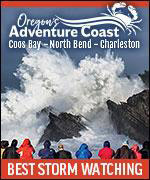 |
Invasive Species Threaten Oregon Coast in Unexpected Way |
|---|
Covering 180 miles of Oregon coast travel: Astoria, Seaside, Cannon Beach, Manzanita, Nehalem, Wheeler, Rockaway, Garibaldi, Tillamook, Oceanside, Pacific City, Lincoln City, Depoe Bay, Newport, Waldport, Yachats & Florence.
04/09/08
Secrets of the Season |
Invasive Species Threaten Oregon Coast in Unexpected Way
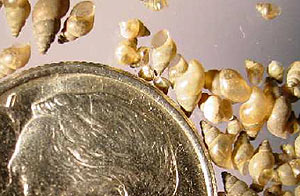 |
| The New Zealand Mud Snail, compared to a coin (photo courtesy State of Washington) |
(Astoria, Oregon) – There’s a fight looming on the horizon: a battle against invading alien creatures so fierce it could rival those epic war scenes on the new season of the “Battlestar Galactica” series.
It’s the citizens of the state of Oregon versus small plants and creatures known as invasive species, which are threatening the state’s landscape, wildlife, waterways, and even beaches along the Oregon coast. Several groups of media organizations and ecologists are kicking off a campaign of information and action this coming Earth Day – April 22 – called “Stop the Invasion.”
It includes a documentary on OPB, volunteer efforts, publications and other organized means to identify, prevent and control these small to tiny beings that could even mean less protection against tsunamis along the Oregon coast.
On the Oregon coast and coastal rivers, the threats are varied. In Young’s Bay, on the north Oregon coast, the New Zealand mud snail is making unwelcome inroads by reproducing in insane numbers and gobbling up the food sources used by native species of snails. Even the algae population – eaten by plenty of other species – is getting sucked up by the New Zealand mud snail.
 |
| Dunes in Seaside covered in beach grass |
For over 100 years, the European beach grass served its purpose well, holding back sand dunes and sand drifts. It, too, was originally an invasive species. But now it’s getting threatened by its American cousin, the American beach grass, which was brought to the mouth of the Columbia River in the 1930’s to also keep down the dunes. The problem is it’s choking out the European variety, which actually did a much better job of dune management.
Foredunes are an integral element in protection against storms and coastal flooding. The American beach grass forms dunes which are about half as high as its predecessor.
Netarts Bay has experienced a small infestation of the Japanese oyster drill (Ceratostoma inornatum). It causes mortality rates up to 25 percent in oyster beds, according to the State of Oregon.
 |
| The bay at Astoria, where some invasive species have been found |
“This campaign truly represents the highest level of collaboration amongst government, nonprofit, and private entities in Oregon,” said Governor Ted Kulongoski. “This is an excellent example of what can happen when people work together to leverage resources to make a difference to Oregon’s native fish and wildlife resources, economy, and quality of life.”
The campaign launches on April 22 at 8 p.m. with the premiere of Oregon Public Broadcasting’s “The Silent Invasion,” a one-hour documentary on invasive species created to raise public awareness and encourage people take action in their own communities.
Also on April 22, two Web sites will launch to help the public take action against invasive species. At the Oregon Invasive Species Hotline, www.opb.org/silentinvasion, Oregonians can report and upload photos of suspected invasives and interact with invasive species experts. The Silent Invasion companion site, www.opb.org/silentinvasion, will provide extensive links and information on invasive species in Oregon including a video archive of stories about invasives in Oregon. The weekly series Oregon Field Guide will continue to focus on invasives species in a number of stories during the year.
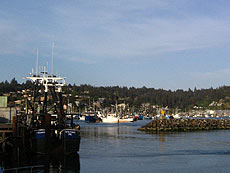 |
| Invasive species often show up in the U.S. through ports like at Newport's Yaquina Bay. |
GardenSmart Oregon: a Guide to Non-invasive Plants will be released in April. The booklet identifies 25 of the most threatening invasive plants across Oregon and recommends non-invasive alternative plants for gardeners and landscapers. This free booklet will be available statewide in garden centers and other businesses and from local government agencies. It was developed by the City of Portland, The Nature Conservancy, Oregon Sea Grant, OSU Extension, Oregon Association of Nurseries, and OPB.
|
Tradewinds Motel, Rockaway Beach. All rooms are immaculate and have TV’s, VCR’s and in-room phones w/ data ports. Oceanfronts have queen bed, a double hide-a-bed, kitchen, cozy firelog fireplace and private deck. Both types sleep up to four people. Others are appointed for a two-person romantic getaway, yet still perfect for those on a budget. Elaborate oceanfront Jacuzzi suite has two bedrooms, kitchen, double hide-a-bed, fireplace and private deck, sleeping as many as six. For family reunions or large gatherings such as weddings, some rooms can connect to create two-room and three-room suites. Some rooms pet friendly. 523 N. Pacific St., Rockaway Beach. (503) 355-2112 - 1-800-824-0938. www.tradewinds-motel.com |
Also in April, over 100,000 OPB members and about 50,000 subscribers to the Statesman Journal are receiving a publication on invasive species that provides specific actions people can take to reduce the spread of invasives.
SOLV is participating in the campaign by coordinating volunteer weed pulls with over 10,000 Oregonians in 2008. Their web site, www.solv.org/programs/invasives.asp, includes a statewide calendar of events for invasive vegetation removal projects.
In addition to contributing to GardenSmart Oregon, The Nature Conservancy is developing an early detection—rapid response program in Oregon. The project trains volunteers to regularly monitor priority natural areas and identify and report invasives so they can be stopped before they spread. More information at www.nature.org/oregon.
 |
| Large foredunes at Gearhart may even protect against tsunamis |
The Oregon Invasive Species Council is serving as a clearinghouse for information and action to address invasive species statewide. The council is a consortium of federal, state, county, and local government agencies, nonprofit organizations, universities, and industry representatives dedicated to a coordinated and comprehensive effort to keep invasive species out of Oregon and to eliminate, reduce, or mitigate the impacts of invasives already present. Web site: www.oregon.gov/OISC/.
Oregon State University and Oregon Sea Grant are conducting pre- and post-campaign surveys to determine how much Oregonians know about invasives species and what ordinary citizens can do to help prevent their spread. This follows focus group studies conducted by the university last year to gauge awareness and attitudes among key stakeholders in Oregon including gardeners, boaters, anglers and hunters. Oregon Sea Grant is also releasing a new publication on aquatic invasive species, On the Lookout for Aquatic Invaders: Identification Guide for the Pacific Northwest.
The Statesman Journal is publishing a series of in-depth articles on invasive species in Oregon and their economic and ecological impacts. The newspaper has also created a comprehensive Web site, www.invasivespeciesoforegon.com, and is producing educational materials for use in classrooms.
 Other
participants in “Stop the Invasion” include the Oregon Departments
of Fish and Wildlife, Agriculture and Forestry, Oregon Marine Board, Port
of Portland, Bureau of Indian Affairs - Warm Springs, USDA Forest Service,
Bureau of Land Management, USDA Plant Protection and Quarantine, U.S.
Fish and Wildlife Service, Portland State University, many cooperative
weed management areas and county weed boards, along with numerous citizens,
corporations, private foundations, and organizations. The “Stop
the Invasion” campaign is receiving national attention because of
the collaboration among government, nonprofit, and private entities and
its scope.
Other
participants in “Stop the Invasion” include the Oregon Departments
of Fish and Wildlife, Agriculture and Forestry, Oregon Marine Board, Port
of Portland, Bureau of Indian Affairs - Warm Springs, USDA Forest Service,
Bureau of Land Management, USDA Plant Protection and Quarantine, U.S.
Fish and Wildlife Service, Portland State University, many cooperative
weed management areas and county weed boards, along with numerous citizens,
corporations, private foundations, and organizations. The “Stop
the Invasion” campaign is receiving national attention because of
the collaboration among government, nonprofit, and private entities and
its scope.
 |
 Inn
at Cannon Beach. Beautifully wooded natural setting at quiet south
end of Cannon Beach. Great during winter storms with a new book by
the fireplace – or when the sun is out for family fun and beach
strolling. Handsome beach cottage-style architecture. Lush flowering
gardens and naturalized courtyard pond. Warm, inviting guest rooms.
Continental buffet breakfast. Warm Cookies. Family and Pet Friendly.
Welcome gifts. Smoke-free. Complimentary Wireless Connectivity. Wine
and book signing events. 800-321-6304 or 503-436-9085. Hemlock At
Surfcrest, Cannon Beach, Oregon. www.atcannonbeach.com. Inn
at Cannon Beach. Beautifully wooded natural setting at quiet south
end of Cannon Beach. Great during winter storms with a new book by
the fireplace – or when the sun is out for family fun and beach
strolling. Handsome beach cottage-style architecture. Lush flowering
gardens and naturalized courtyard pond. Warm, inviting guest rooms.
Continental buffet breakfast. Warm Cookies. Family and Pet Friendly.
Welcome gifts. Smoke-free. Complimentary Wireless Connectivity. Wine
and book signing events. 800-321-6304 or 503-436-9085. Hemlock At
Surfcrest, Cannon Beach, Oregon. www.atcannonbeach.com. |
 |
|
The Ocean Lodge. There will not be another property built like this in Cannon Beach in our lifetimes. Rare, premiere ocean front location; handsome, dramatic architecture and tasteful, fun (nostalgic) beach interiors. Overlooks Haystack Rock. 100 percent smoke free. Imaginative special occasion packages. Massive wood burning lobby fireplace. Library w/ fireplace, stocked with impressive book collection. Pet and family friendly. Lavish continental buffet breakfast. In-room fireplaces, mini-kitchens. Jacuzzi tubs in select rooms. DVD players, complimentary movies. Morning paper. Warm cookies. 888-777-4047. 503-436-2241. 2864 Pacific Street. Cannon Beach, Oregon. www.theoceanlodge.com |
 |
|
Arch
Cape Property Services.
Dozens of homes in that dreamy,
rugged stretch between Cannon Beach and Manzanita known as Arch
Cape. Oceanfront and ocean view , or just a short walk from the
sea. |
RELATED STORIES
Click here for video of Dec. storm aftermath
Oregon Coast Best of Awards for the Year And the winners are: best of Oregon coast restaurants, lodgings, science, odd events in nature and stunning moments for 2007
Watching Transformations of Oregon Coast Beaches Seasons change and so do beaches, revealing different sides and a variety of eye-popping sights
Staggeringly Cool Ideas for Oregon Coast Romance Be it the season of Valentine's or be it any time of the year, Oregon's coastline has essentially cornered the market for cuddle-inducing possibilities and gushy activities for the hand-holding set
Day or Night Mysteries and Merriment on Oregon Coast It's more than just nightlife that comes to life, but the beaches offer major opportunities
Oregon Coast Travel Site Goes Wireless Provides Lodging Reports - Oregon Coast Beach Connection now has mobile lodging and dining listings, along with weekly lodging availability reports


